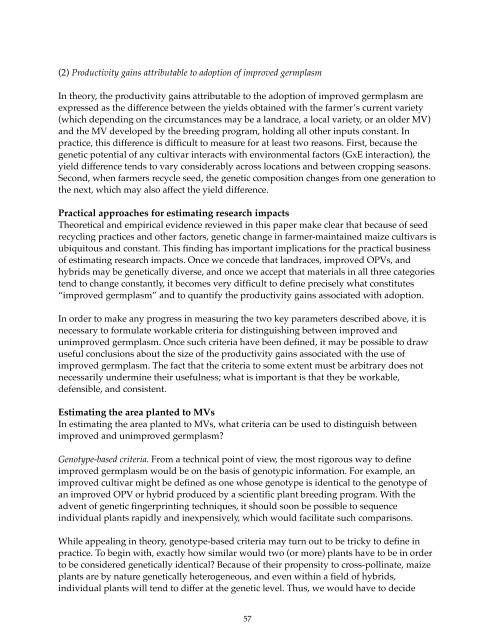A Review of the Evidence - Search CIMMYT repository
A Review of the Evidence - Search CIMMYT repository
A Review of the Evidence - Search CIMMYT repository
Create successful ePaper yourself
Turn your PDF publications into a flip-book with our unique Google optimized e-Paper software.
(2) Productivity gains attributable to adoption <strong>of</strong> improved germplasmIn <strong>the</strong>ory, <strong>the</strong> productivity gains attributable to <strong>the</strong> adoption <strong>of</strong> improved germplasm areexpressed as <strong>the</strong> difference between <strong>the</strong> yields obtained with <strong>the</strong> farmer’s current variety(which depending on <strong>the</strong> circumstances may be a landrace, a local variety, or an older MV)and <strong>the</strong> MV developed by <strong>the</strong> breeding program, holding all o<strong>the</strong>r inputs constant. Inpractice, this difference is difficult to measure for at least two reasons. First, because <strong>the</strong>genetic potential <strong>of</strong> any cultivar interacts with environmental factors (GxE interaction), <strong>the</strong>yield difference tends to vary considerably across locations and between cropping seasons.Second, when farmers recycle seed, <strong>the</strong> genetic composition changes from one generation to<strong>the</strong> next, which may also affect <strong>the</strong> yield difference.Practical approaches for estimating research impactsTheoretical and empirical evidence reviewed in this paper make clear that because <strong>of</strong> seedrecycling practices and o<strong>the</strong>r factors, genetic change in farmer-maintained maize cultivars isubiquitous and constant. This finding has important implications for <strong>the</strong> practical business<strong>of</strong> estimating research impacts. Once we concede that landraces, improved OPVs, andhybrids may be genetically diverse, and once we accept that materials in all three categoriestend to change constantly, it becomes very difficult to define precisely what constitutes“improved germplasm” and to quantify <strong>the</strong> productivity gains associated with adoption.In order to make any progress in measuring <strong>the</strong> two key parameters described above, it isnecessary to formulate workable criteria for distinguishing between improved andunimproved germplasm. Once such criteria have been defined, it may be possible to drawuseful conclusions about <strong>the</strong> size <strong>of</strong> <strong>the</strong> productivity gains associated with <strong>the</strong> use <strong>of</strong>improved germplasm. The fact that <strong>the</strong> criteria to some extent must be arbitrary does notnecessarily undermine <strong>the</strong>ir usefulness; what is important is that <strong>the</strong>y be workable,defensible, and consistent.Estimating <strong>the</strong> area planted to MVsIn estimating <strong>the</strong> area planted to MVs, what criteria can be used to distinguish betweenimproved and unimproved germplasm?Genotype-based criteria. From a technical point <strong>of</strong> view, <strong>the</strong> most rigorous way to defineimproved germplasm would be on <strong>the</strong> basis <strong>of</strong> genotypic information. For example, animproved cultivar might be defined as one whose genotype is identical to <strong>the</strong> genotype <strong>of</strong>an improved OPV or hybrid produced by a scientific plant breeding program. With <strong>the</strong>advent <strong>of</strong> genetic fingerprinting techniques, it should soon be possible to sequenceindividual plants rapidly and inexpensively, which would facilitate such comparisons.While appealing in <strong>the</strong>ory, genotype-based criteria may turn out to be tricky to define inpractice. To begin with, exactly how similar would two (or more) plants have to be in orderto be considered genetically identical? Because <strong>of</strong> <strong>the</strong>ir propensity to cross-pollinate, maizeplants are by nature genetically heterogeneous, and even within a field <strong>of</strong> hybrids,individual plants will tend to differ at <strong>the</strong> genetic level. Thus, we would have to decide57
















